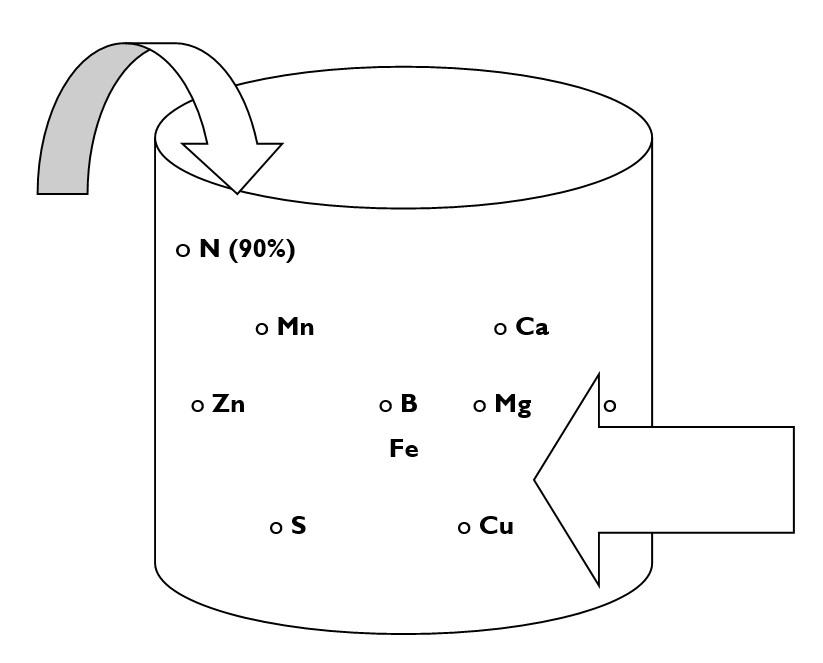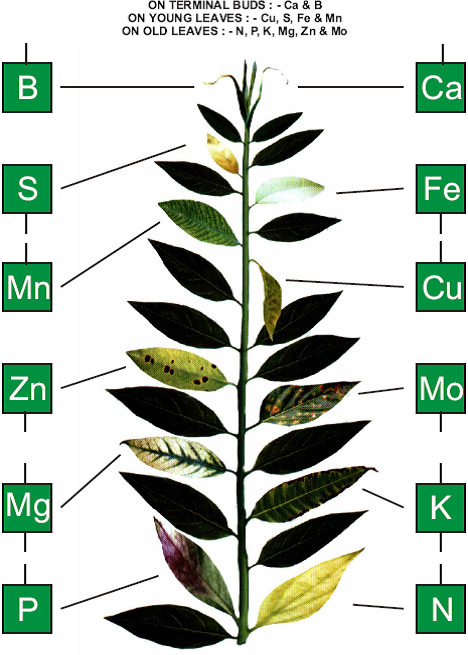Introduction
Plant nutrient elements are divided into two groups called Macro- and Micro-elements. The effect of the most limiting nutrient element can be illustrated by trying to fill a drum or barrel with holes at various levels on its side. Each hole represents the relative optimal concentration of a nutrient element. In the sketch below, nitrogen (N) is present at 90% and potassium (K) at 30% of their respective optimal concentrations. To fill the drum, one has to first of all block the hole representing K. Thereafter, you can fill the drum to the level where phosphorus (P) becomes the most limiting nutrient element.
If you first block the nitrogen (N) hole before blocking the K hole you still will not be able to fill the drum more than 30%. Therefore, to fill the drum all nutrient elements must be present at their respective optimal concentration (100% level) but getting the N level to 100% and not the K level will not enable the plant to produce at 100% capacity. Although molybdenum is required in very small quantities compared to nitrogen, the shortage of this element will still cause the plant to produce at only 40% of its capacity in the example below.
Macro Elements
Soil fertility is a collective term used to describe the status of the soil in terms of phosphorus (P), potassium (K), calcium (Ca), magnesium (Mg) and to some extent, nitrogen (N). Fertile soil contains these nutrient elements in adequate quantities to sustain plant growth.

The Symptoms of Nutrient Deficiencies
|
Nutrient Element |
Plant Part (first to display symptoms) |
Mild Expression |
Severe Expression |
|
Nitrogen (N) |
Old leaves |
Yellowing of all the old leaves, to a light yellow colour. |
Yellowing of all leaves just before or during a new leaf flush will result in leaf drop. |
|
Phosphorus (P) |
Fruit |
Open centre resembling over-matured fruit. |
Thick skins and puffy fruit with high acid levels. |
|
Potassium (K) |
Fruit |
Small fruit |
Small fruit with thin skins combined with a low yield. On young trees, the leaves may turn bronze. |
|
Calcium (Ca) |
Fruit |
Increase incidence of creasing, (a physiological disorder) although not yet confirmed. |
Chlorosis (yellowing) of very young leaves and dieback of growth tips.
|
|
Magnesium (Mg) |
Old leaves |
Chlorosis of the front part of the leaf from the tip and sides of the leaf. An inverted green V with the open end of the V at the petiole side appears as the symptom develops. |
Leaf drop and decrease in fruit set. |
|
Sulphur (S) |
New leaves |
Yellowing to the colour of butter of emerging leaves on a green twig. |
Extremely reduced fruit set. |
|
Copper (Cu) |
New leaves |
Extra-large leaves strong new growth. |
Gum pockets in the albedo (white part of the peel) of the fruit. Fruit is small, thin-skinned and hard. |
|
Iron (Fe) |
New leaves |
Yellowing of the lamina (leaf blade) of young leaves leaving a well-defined network of small veins. |
Reduced fruit set. |
|
Manganese (Mn) |
New leaves |
Inter-veinal yellowing of a normal-sized leaf, almost over the entire leaf. Broad green areas around the veins and Chlorotic areas between veins are the most obvious symptoms. |
Increase in the number of leaves affected. |
|
Zinc (Zn) |
New leaves |
Interveinal yellowing of a small-sized leaf, starting at the tip of the leaf. Resembles manganese deficiency but appears on small leaves and the chlorosis starts at the tip of the leaf. |
An increase in the number of leaves affected and a reduction in fruit size. |
|
Boron (B) |
New leaves |
Corking of the midrib vein on the underside of the leaves. This resembles the cold damage of leaves. |
Gum pockets around the centre of the fruit. Fruit size is reduced. |
Identifying Nutrient Deficiencies In Plants
The most important features of nutrient element deficiencies are:
- The leaf should display the same symptom on both the left-hand and right-hand sides of the midrib. This is important in distinguishing between nutrient deficiencies and leaf symptoms caused by other factors.
- Nutrient deficiency symptoms appear first on either new or old leaves. From there the symptom can spread to the entire plant.
- Certain nutrient deficiency symptoms appear first or are more noticeably on fruit.
- Nutrient deficiency starts with mild symptoms and develops into severe symptoms.

Correcting Nutrient Deficiencies
The first response to detecting nutrient deficiency symptoms is to report it to the supervisor or manager.
The presence of nutrient deficiency symptoms is a sign of an unsuccessful fertilisation program. Deficiency symptoms generally appear after the shortage has had an impact on the plant and/or production. The fertilisation program should provide methods to identify and correct short supplies of any essential nutrient element before it impacts the crop.
Rectifying nutrient deficiencies is seldom a simple matter of applying the nutrient. Very often the deficiency is the result of factors other than an absolute short supply. A deficiency can be induced by other factors that convert the specific nutrient into an unavailable form. It could also be the nutrient has been converted to a less active form. To improve the supply of the specific nutrient, one needs to determine why its supply is not optimal (the best it can be) and try to correct that.
Once it has been applied to the plant, there is no guarantee that the active form will last long enough to result in the required physiological reactions. To maintain optimal concentrations of the available nutrient elements in the trees, enough of the nutrient in the available form must be present to be utilised by the plant.
The table below lists the most common causes and factors associated with nutrient deficiencies, and the corrective measure that can be taken.
Symptoms of Nutrient Deficiencies in Crops and Potential Corrective Actions
|
Nutrient Element |
Causes of Deficiency and Factors that Can Induce a Deficiency |
Corrective Actions |
|
Nitrogen (N) |
Too little applied |
Increase the application. |
|
Too much lost due to leaching |
Split the application and control the irrigation better. |
|
|
Phytophthora (root rot) |
Treat the disease with foliar sprays. |
|
|
Phosphorus (P) |
Too little applied |
Increase the application. |
|
Soil pH too high |
Not much to be done. |
|
|
Soil pH too low |
Apply lime to the soil. |
|
|
Potassium (K) |
Too little applied |
Increase the application. |
|
Mg supply too high |
Apply K through foliar sprays. |
|
|
Trees old |
Not much to be done. |
|
|
Nematodes |
Treat the pest. |
|
|
Calcium (Ca) |
Too little applied |
Increase the application. |
|
Climatic conditions |
Increase the application during critical periods. |
|
|
Soil pH too low |
Apply lime to the soil. |
|
|
Magnesium (Mg) |
Too little applied |
Increase the application. |
|
K supply is too high |
Apply Mg through foliar sprays. |
|
|
Soil pH too low |
Apply lime to the soil. |
|
|
Sulphur (S) |
Too little applied |
Increase the application. |
|
Copper (Cu) |
Too little applied |
Increase the application. |
|
Soil pH too high |
Apply Cu through foliar sprays. |
|
|
Iron (Fe) |
Too little applied |
Increase the application. |
|
Soil pH too high |
Use soil application of a chelate that is stable at a high pH. |
|
|
Over-irrigation |
Reschedule the irrigation. |
|
|
Manganese (Mn) |
Too little applied |
Increase the application. |
|
Soil pH too high |
Apply Mn through foliar sprays. |
|
|
Recent application of lime |
Apply Mn through foliar sprays. |
|
|
Zinc (Zn) |
Too little applied |
Increase the application. |
|
Soil pH too high |
Apply Zn through foliar sprays. |
|
|
Too much P applied |
Apply Zn through foliar sprays. |
|
|
Boron (B) |
Too little applied |
Increase the application. |
|
Too low pH in the soil |
Apply lime to the soil. |